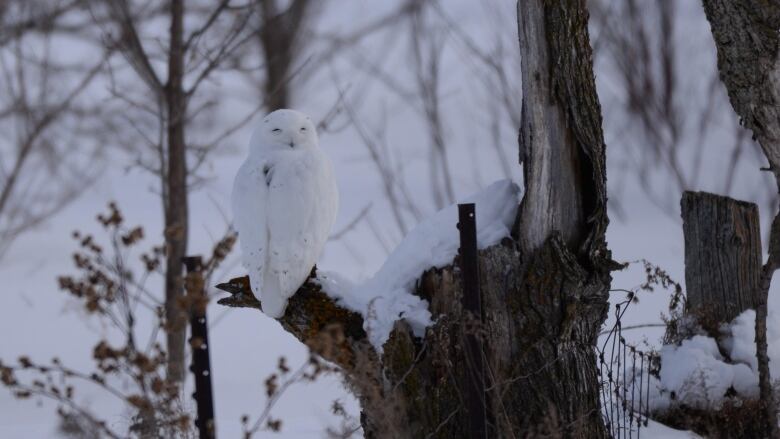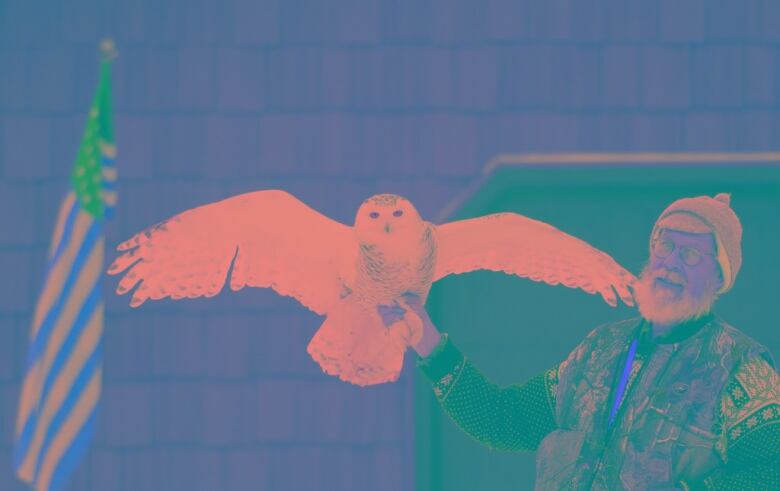Snowy owl's return to Ottawa may hold clues to Arctic changes
Snowy owl named Hardscrabble equipped with tracker allowing researchers to follow flight

Bird watchers steady your binoculars; Hardscrabblehas returned.
The four-year-old snowy owl has picked a corn field in the Ottawa Valley for a second winter in a row and with his arrival comes a potential treasure trove of information.
That's because like a satellite emerging fromthe dark side of a moon Hardscrabblehas returned to the land of cellular towers from the Arctic and the electronic transmitter strapped to his back is about to send a major data dump about where he's been since last spring.
The owl is part of an international operation called Project Snowstorm, an attempt to track the birds to understand their winter ecology, and why for the last five winters they have been migrating south in unprecedented numbers.

Few birds keep data trackers
"For us it's really exciting," said Daniel Lafortune, a volunteertasked by Project Snowstorm to head out to the location where Hardscrabble's transmission pinged a cell-tower in Renfrew County earlier this week.
It's the second winter he and his wife Patricia have been charged with identifying Hardscrabble, to make sure the bird is OK and still wearing his equipment and to observe and photograph the bird.
"It's great because it's onewe know [one] we've played hide and seek with," Lafortunesaid.
Hardscrabble was named after the road in New York State where volunteers from the U.S. based groupfirst found him in February 2016, and fitted him with a miniature $3,500 state-of-the-art solar-powered transmitter.
Very few of the 50 backpacks fitted to the birdshave managed to stay on long enough to show themigration pattern of the birdsafter leaving the south for the Arctic.Even fewer have stayed on for two seasons in a row, making Hardscrabble a bit of a rising star.

"He's famous for usbecausewe don't have a lot of owls that go back and forth," explainedDavidBrinker, a wildlife ecologist with the Maryland Department of Natural Resources, and a founding member of Project Snowstorm.
"And that's very exciting."
'Something may not be right anymore'
The transmitter will take about two days to recharge and then will begin sending data that could holdclues as to why there havebeen dramatic changes in the migration of Snowy Owls heading south.
Snowy owls have had sudden population booms or irruptions before, often in line with baby booms in prey, but in 2013, theirruption was more like an explosion not observed in almost 100 years with thousands of Snowy Owls pushing as far south as Georgia State with sightings as far as Florida, even theCarribeanIslands.
Dramatic changes to the Arctic linked to climate change have researchers concerned that the sudden appearance of the owls may not be good news.
"I think it very well could be a situation where this wonderful irruption of owls that we're seeing is a little bit of a signal flying into our lives," said Brinker.
"It's saying 'hey folks, think about what's going on here, something may not be right anymore.'"
My first snowy owl of the season. My favourite Bird to witness in flight, sitting or hunting. A real ghost of the Arctic. safe distance from wildlife pic.twitter.com/qXDYjeGfDL
—@rolandbastphotoThis month the International Union for Conservation of Naturepointed to climate change as a threat to the snowy owl, moving it up from "Least Concern" to "Vulnerable" on its species 'red list.'
"Worrying new information from the North American Arctic lists the iconic snowy owl (Bubo scandiacus) as threatened for the first time," states its recent report, suggesting the population is much smaller than thought, showing a drop of 30 to 49 per centin three generations.
"Climate change is among a number of threats to the species, affecting snow melt which in turn reduces availability of rodent prey," the report found.

Map of snowy owl sightings 'startling'
Ontario's Ministry of Natural Resources has also been tracking sightings of the birds, including a banding program of its own, but most of the data depends on citizen reporting through sites like theeBird.
"The map for snowy owls the past two months is really quite startling," said Don Sutherland, a zoologist with the ministry's Heritage Information Centre in Peterborough, Ont.
"Perhaps they are the proverbial canaries in the coal mine," said Sutherland, "And they may be providing us with important clues as to what's going on."
The sudden surge of owls in the Ottawa region hasbeen a spectacular sight for bird watchers.
Saturday, Patricia and Daniel Lafortune will drive the couple of hours from Ottawa to make a positive identification on Hardscrabble.
"Just based on the time we spent (the owls) taught us a lot," said Daniel Lafortune, in particular, how adaptable they are from what they eat, to adjusting to life with humans.
"My feeling is that the future of the owl is still good."












_(720p).jpg)


 OFFICIAL HD MUSIC VIDEO.jpg)
.jpg)



























































































